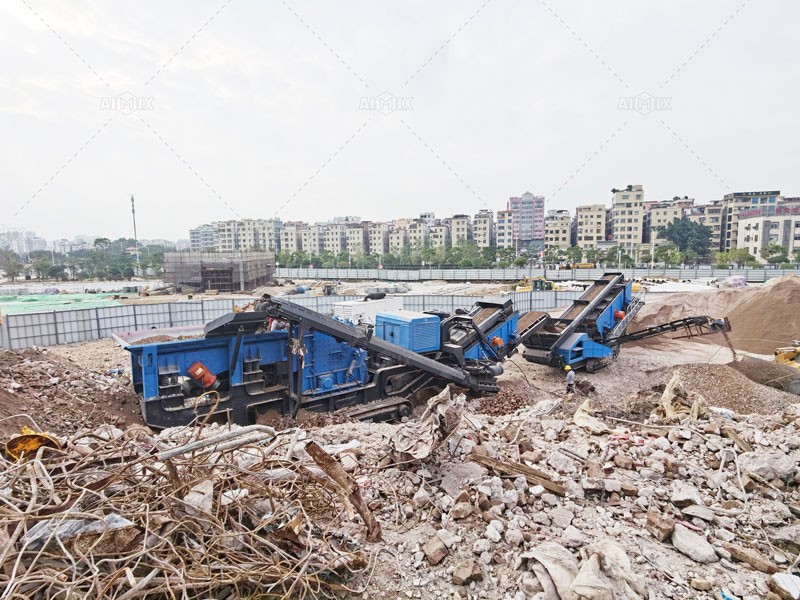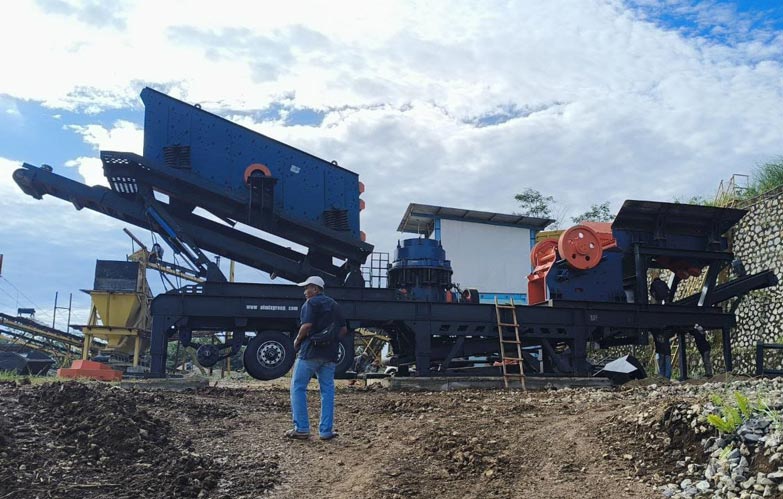Detailed Explanation of Pre-Installation Preparations for Aggregate Crushing Plants
The successful installation of an aggregate crushing plant is critical for ensuring the efficient processing of raw materials in the mining and construction industries. However, the installation process begins long before the first piece of equipment is placed on-site. Pre-installation preparation is a crucial phase that can determine the success of the entire project. It involves careful planning, site evaluation, and proper resource allocation to ensure that the aggregate crusher plant operates at peak efficiency once it is set up.
In this article, we will explore the essential steps involved in the pre-installation preparation for an aggregate crushing plant(planta trituradora de agregados), highlighting the importance of each phase for a smooth and efficient setup.
Contents |
[edit] Site Evaluation and Preparation
[edit] 1. Choosing the Right Location
The first and most critical aspect of pre-installation preparation is selecting an appropriate site for the aggregate crushing plant. The location should be spacious, stable, and easily accessible for the transportation of equipment, raw materials, and finished aggregates.
When evaluating potential sites, consider factors like topography, environmental impact, and proximity to raw material sources. The site should have enough space for not only the gravel crusher(trituradora de piedra para grava) and other equipment but also for conveyors, screens, and stockpiles of raw materials and finished products.
[edit] 2. Ground Preparation
Once the site is chosen, it’s time to prepare the ground for the installation of the aggregate crusher plant. This involves clearing the site of vegetation, debris, and rocks, as well as leveling the ground to ensure the proper installation of equipment.
In many cases, the ground will need to be reinforced or compacted to provide a solid foundation for the crushing machinery. If necessary, excavation work should be done to ensure that the equipment is placed on stable ground, minimizing vibrations and ensuring long-term operational stability.
[edit] 3. Site Accessibility
The accessibility of the site is another critical factor in the pre-installation phase. The crushing plant will require regular maintenance, and the transportation of parts, raw materials, and finished products will be ongoing throughout the plant’s life. Ensure that the site is easily accessible by roads wide enough for trucks, heavy machinery, and cranes.
A well-planned access route minimizes potential delays during the installation process and ensures that operators and maintenance teams can easily reach the plant during regular operations.
[edit] Equipment Review and Specification
[edit] 1. Assessing Plant Requirements
The next step in pre-installation preparation is reviewing the operational requirements of the aggregate crusher plant. This includes determining the type and capacity of the gravel crusher and understanding the expected output. This information will guide the selection of other equipment needed for the plant, such as conveyors, screens, feeders, and hoppers.
Carefully assessing these requirements ensures that all the equipment works together seamlessly to meet the desired production goals. Each component must be able to handle the load and type of material being processed without causing bottlenecks or inefficient operations.
[edit] 2. Understanding Equipment Specifications
Once the required equipment is selected, it’s essential to review the detailed specifications of each piece of machinery. This includes checking the operational limits, power requirements, and maintenance needs of the gravel crusher and other plant components. Ensuring that all equipment meets the specifications required for efficient operation is vital for a smooth installation process.
Equipment specifications will also guide the electrical and hydraulic connections, ensuring that all systems are compatible and can be integrated smoothly during the installation phase.
[edit] Resource Allocation and Team Preparation
[edit] 1. Human Resources
Successful pre-installation preparation also involves careful coordination of human resources. Skilled technicians, engineers, and laborers should be available to handle the various aspects of the installation process. Ensure that the installation team has experience with aggregate crushing plants, as they will be responsible for assembling the equipment, making electrical and hydraulic connections, and testing the plant once it’s installed.
[edit] 2. Material and Tool Preparation
Material preparation is another essential step in pre-installation planning. Ensure that all necessary materials, such as bolts, screws, and tools for assembly, are available on-site before installation begins. It’s crucial to verify that all parts of the gravel crusher and other components are delivered on time to avoid unnecessary delays during installation.
The team should also ensure that the required safety equipment, such as helmets, gloves, and protective clothing, is readily available for all workers involved in the installation process.
[edit] 3. Time Management and Scheduling
Having a clear timeline and schedule is crucial for keeping the pre-installation process on track. Develop a detailed timeline that outlines the phases of preparation, including site preparation, equipment delivery, assembly, and testing. Scheduling helps ensure that all tasks are completed in an organized manner and that resources are allocated efficiently.
[edit] Regulatory Compliance and Safety Standards
[edit] 1. Ensuring Compliance with Local Regulations
Before installation begins, it’s important to verify that the aggregate crushing plant complies with all local laws and environmental regulations. This includes acquiring any necessary permits for construction, mining, and operation, as well as ensuring that the plant meets health, safety, and environmental standards.
In many cases, environmental impact assessments (EIA) are required before construction can begin. These assessments evaluate how the installation of the plant will affect the surrounding environment, including air quality, water sources, and wildlife habitats. Compliance with these regulations helps avoid legal issues and ensures that the plant can operate without causing significant harm to the environment.
[edit] 2. Safety Protocols
Ensuring the safety of workers during the installation process is a priority. Establish clear safety protocols for workers on-site, including guidelines for handling heavy machinery, working at heights, and performing electrical or mechanical tasks. Training programs should be conducted to ensure that workers are familiar with safety practices, and the site should be equipped with emergency response equipment, including fire extinguishers, first aid kits, and safety barriers.
[edit] Conclusion
The pre-installation phase for an aggregate crusher plant is essential for setting up a successful and efficient crushing operation. By carefully evaluating the site, preparing the ground, reviewing equipment specifications, and organizing human and material resources, you can ensure a smooth installation process. Additionally, adherence to safety standards and regulatory requirements ensures that the plant will operate safely and legally once up and running.
By following these key steps, you lay the groundwork for an efficient, reliable, and productive gravel crusher operation, minimizing downtime and ensuring long-term success in your mining or aggregate processing endeavors.
Featured articles and news
One of the most impressive Victorian architects. Book review.
RTPI leader to become new CIOB Chief Executive Officer
Dr Victoria Hills MRTPI, FICE to take over after Caroline Gumble’s departure.
Social and affordable housing, a long term plan for delivery
The “Delivering a Decade of Renewal for Social and Affordable Housing” strategy sets out future path.
A change to adoptive architecture
Effects of global weather warming on architectural detailing, material choice and human interaction.
The proposed publicly owned and backed subsidiary of Homes England, to facilitate new homes.
How big is the problem and what can we do to mitigate the effects?
Overheating guidance and tools for building designers
A number of cool guides to help with the heat.
The UK's Modern Industrial Strategy: A 10 year plan
Previous consultation criticism, current key elements and general support with some persisting reservations.
Building Safety Regulator reforms
New roles, new staff and a new fast track service pave the way for a single construction regulator.
Architectural Technologist CPDs and Communications
CIAT CPD… and how you can do it!
Cooling centres and cool spaces
Managing extreme heat in cities by directing the public to places for heat stress relief and water sources.
Winter gardens: A brief history and warm variations
Extending the season with glass in different forms and terms.
Restoring Great Yarmouth's Winter Gardens
Transforming one of the least sustainable constructions imaginable.
Construction Skills Mission Board launch sector drive
Newly formed government and industry collaboration set strategy for recruiting an additional 100,000 construction workers a year.
New Architects Code comes into effect in September 2025
ARB Architects Code of Conduct and Practice available with ongoing consultation regarding guidance.
Welsh Skills Body (Medr) launches ambitious plan
The new skills body brings together funding and regulation of tertiary education and research for the devolved nation.
Paul Gandy FCIOB announced as next CIOB President
Former Tilbury Douglas CEO takes helm.
























